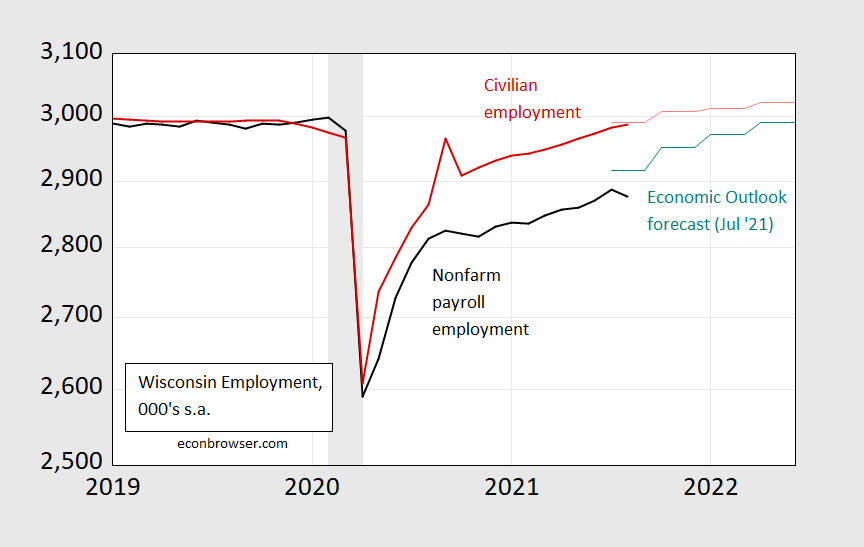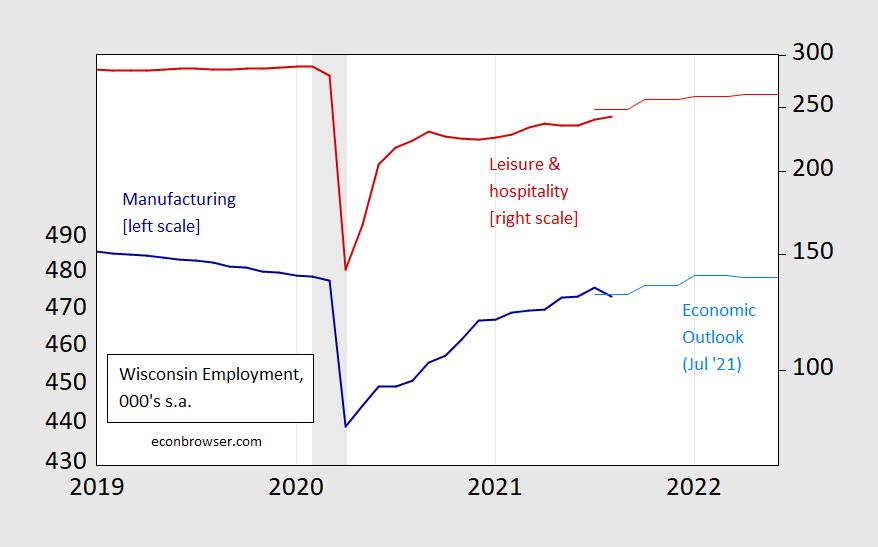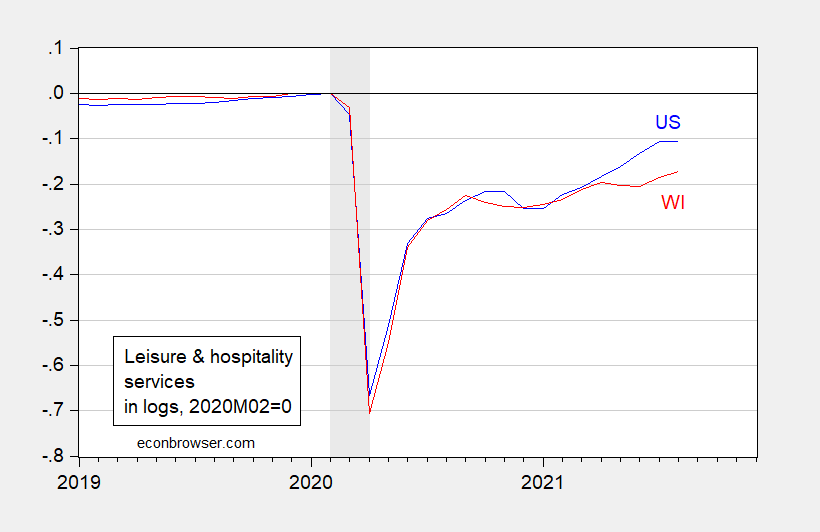Employment numbers for August were released yesterday. Nonfarm payroll employment fell, and is undershooting the July 2021 Economic Forecast:
Figure 1: Wisconsin nonfarm payroll employment from August release (black), forecast from July 2021 Economic Outlook, released in August (teal), civilian employment (red), forecast (pink), all in 000’s, seasonally adjusted. NBER defined recession dates shaded gray. Source: BLS, DWD, NBER, and Wisconsin Department of Revenue.
Civilian employment — which is measured with much greater error — continued to rise, coming close to forecast levels. The biggest month-on-month decline in a category (below main aggregates) was in Education and Health Services (at 7100), which might make one think seasonal adjustment is an issue; however, the main contributor to the decline was in health care and social assistance. There still might be a seasonal adjustment issue, but it’s not obvious to me what it is. The decline in Education and Health Services accounted for over 2/3 of the 10400 m/m decline in NFP employment.
The dualistic nature of the recovery persists, with high contact services employment remaining more depressed than that for goods production. The recovery in leisure and hospitality seems to have stalled (according to seasonally adjusted numbers), while manufacturing fell. Still Manufacturing employment is much closer to pre-covid levels than Leisure and Hospitality services. The latter is 15.9% below 2020M02 levels, while the former is a mere 1.1% below.
Figure 2: Wisconsin manufacturing employment release (dark blue, left scale), and July 2021 forecast from Wisconsin Economic Forecast released in August (light blue, left scale), leisure and hospitality services (dark red, right scale), and July forecast (pink line, right scale), all in 000’s, seasonally adjusted. NBER defined recession dates shaded gray. Source: BLS, DWD, NBER, and Wisconsin Department of Revenue.
While leisure and hospitality services employment continued to grow, it’s a halting progress, and lags what has happened in the rest of the country. Nationally, leisure and hospitality services employment is down 10%, compared to Wisconsin’s 15.9%. Neighboring Minnesota’s corresponding employment is down 13.6% (interestingly, full vaccination rates there are currently about 57.3%, while those in Wisconsin are about 55.3%).
Figure 3: US leisure and hospitality services employment (blue), and Wisconsin (red), both in logs, 2020M02=0, seasonally adjusted. NBER defined recession dates shaded gray. Source: BLS, DWD, NBER, and and author’s calculations.
The diverging paths of employment registered from the establishment (CES) versus household (CPS) surveys is a reminder that the August figures are preliminary (although I would put bigger weight on the establishment survey numbers, for reasons outlined here).



https://fred.stlouisfed.org/graph/?g=mm0p
January 15, 2018
Real Median Weekly Earnings * and Corporate Profits After Tax, ** 1980-2021
* All full time wage and salary workers
** With Inventory Valuation and Capital Consumption Adjustments
(Indexed to 1980)
https://fred.stlouisfed.org/graph/?g=GPGK
January 15, 2018
Real Median Weekly Earnings for men & women * and Corporate Profits After Tax, ** 1980-2021
* All full time wage and salary workers
** With Inventory Valuation and Capital Consumption Adjustments
(Indexed to 1980)
I wanted to share this, but didn’t know what blog thread it fits in. Labor markets tied to Covid-19 now?? Kinda….. so maybe here it semi-fits:
https://news.yahoo.com/just-cry-time-non-covid-114106344.html
People on the political right call themselves “Christian” yet clearly exhibit a refusal to consider how their actions effect their neighbors’ lives. Claiming your “freedom” (which is an incorrect label for the privilege of living in a country with efficacious vaccines) supersedes others’ choice of living or dying is astoundingly selfish.